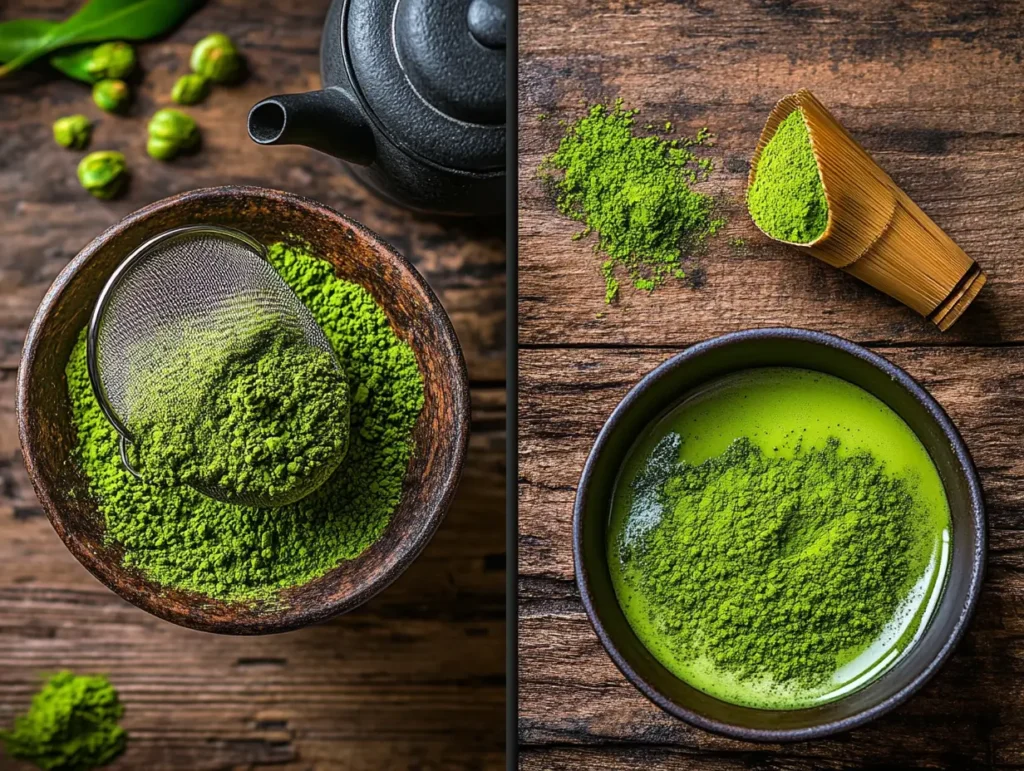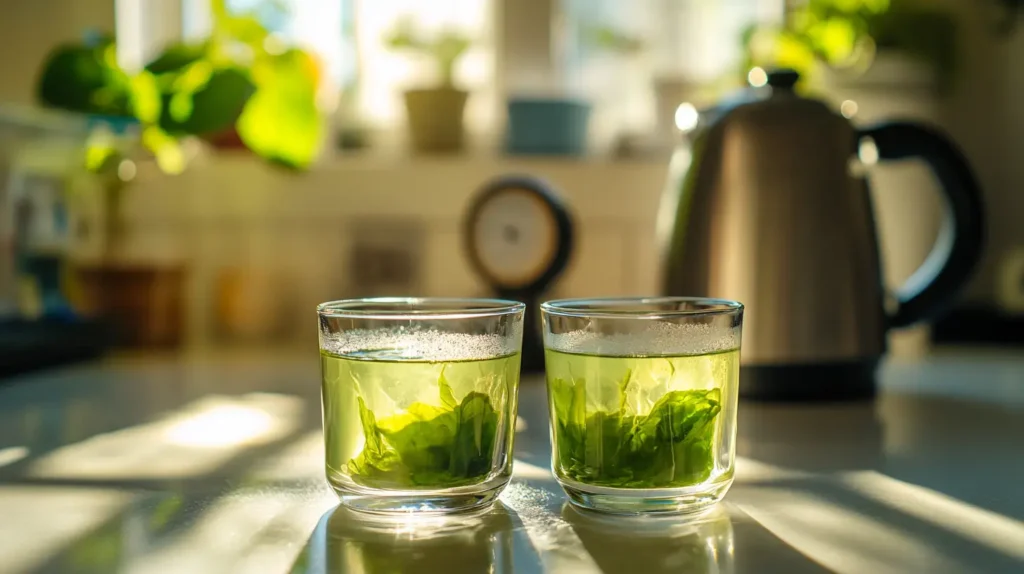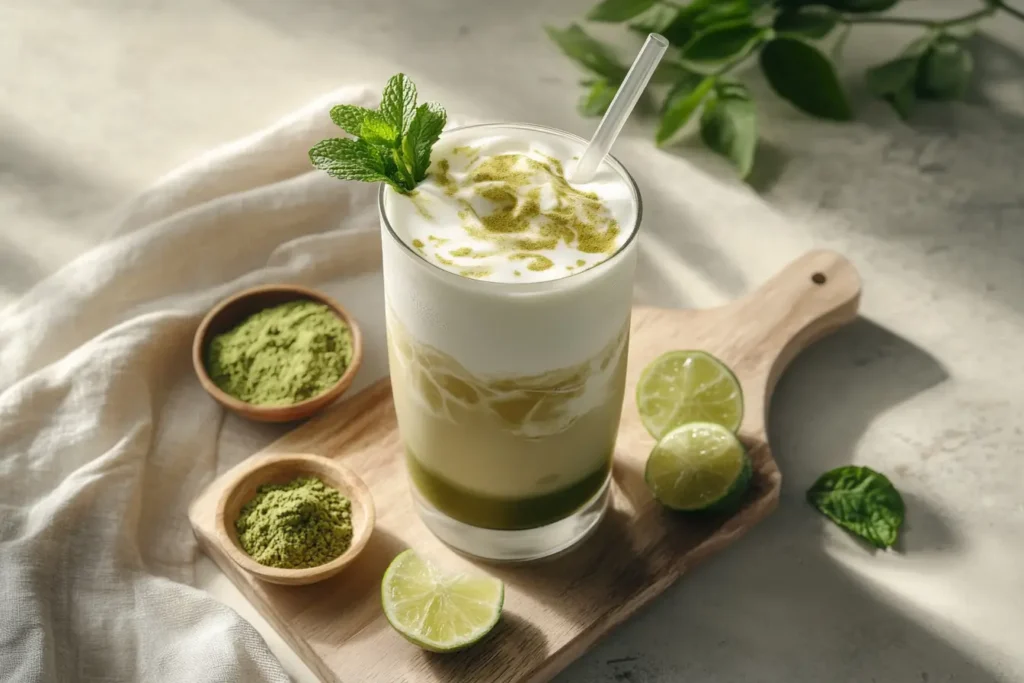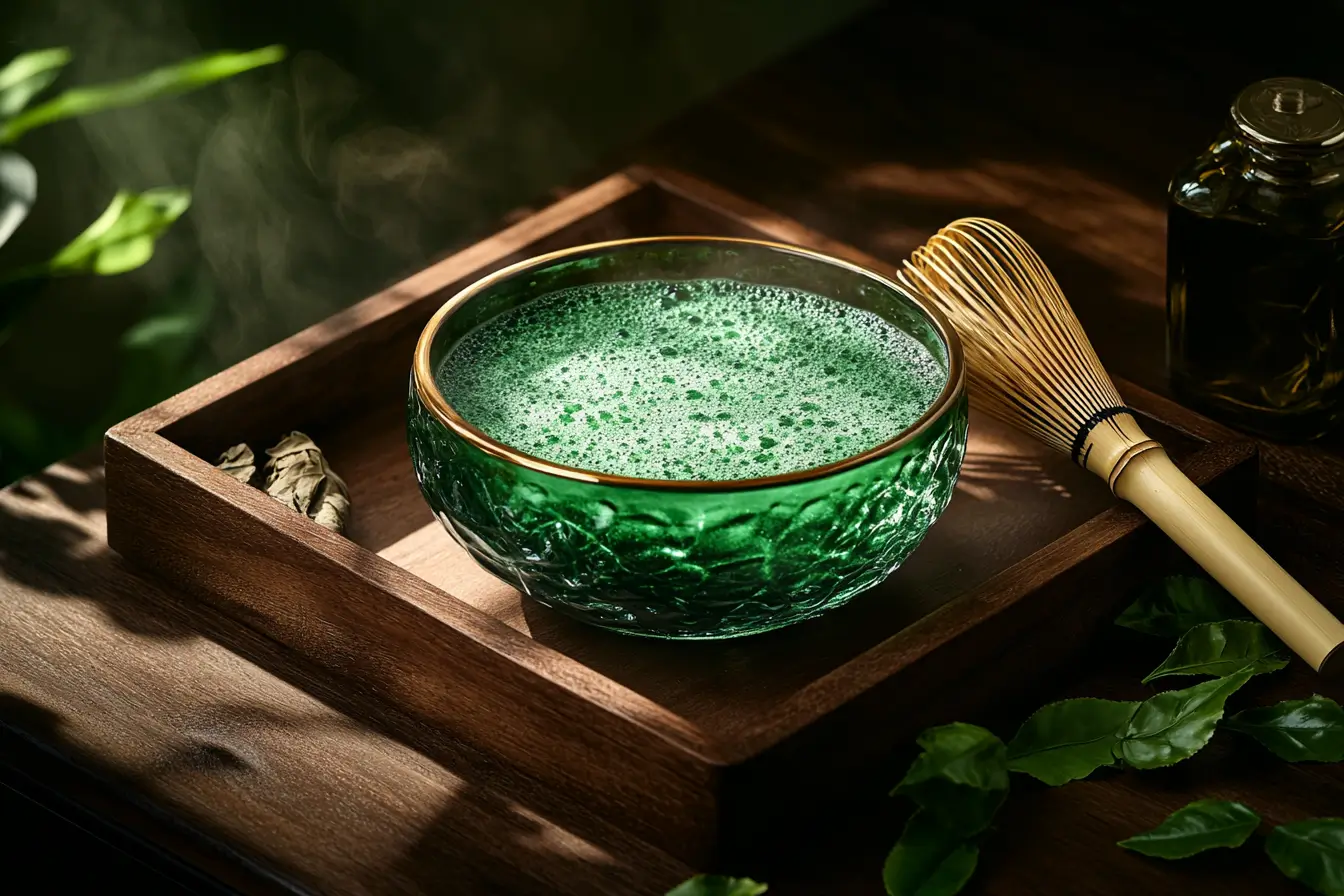Matcha, a vibrant green tea powder, is becoming increasingly popular worldwide, especially among health-conscious individuals and breakfast enthusiasts. But many people often wonder, “Can you put matcha in hot water?” The answer is yes, but it’s essential to prepare it the right way to avoid ruining its delicate flavor and abundant nutrients. This guide will walk you through everything you need to know about making a perfect cup of matcha while explaining the significance of water temperature and how it impacts your brew. By the end, you’ll feel confident incorporating matcha into your morning routine and beyond.
Table of Contents
Introduction to Matcha
What Is Matcha?
Matcha is a finely ground Japanese green tea powder made from specially grown and shaded tea leaves. Unlike regular green tea, where the leaves are steeped and discarded, matcha involves consuming the entire leaf. This means you get a more concentrated dose of nutrients, antioxidants, and caffeine. Matcha is known for its bright green color, which is a result of the high chlorophyll content from its shading process before harvest.
Consuming matcha offers a unique, slightly bitter yet earthy flavor with a smooth texture when prepared correctly. Its ability to boost energy without causing a jittery crash has made it a favorite among busy parents, students, and working professionals looking for a healthier alternative to coffee.
Why Matcha Is Perfect for Breakfast
Starting your day with matcha is not just a treat for your taste buds—it’s also a fantastic way to fuel your body. Matcha provides a steady energy boost thanks to the combination of caffeine and L-theanine, an amino acid that promotes calmness and focus. Unlike coffee, which can cause energy spikes and crashes, matcha supports calm alertness throughout your morning. Paired with breakfast favorites like oatmeal, toast, or a smoothie, matcha can help you feel energized and ready to tackle your day.
Why Water Temperature Matters for Matcha

The Science of Brewing Matcha
Water temperature plays a critical role in making matcha. If you’ve ever experienced a bitter or unpleasant cup of matcha, it’s likely due to using water that was too hot. Matcha contains delicate compounds, such as amino acids, catechins, and chlorophyll, which degrade when exposed to extreme heat. Proper water temperature preserves these nutrients and ensures the tea’s characteristic umami flavor remains intact.
Additionally, using cooler water allows the matcha to dissolve more evenly, preventing clumps and creating a smooth, creamy texture.
Ideal Water Temperature for Matcha
The ideal water temperature for matcha is between 70°C and 80°C (158°F to 176°F). Water that is too hot will burn the powder, turning its vibrant green color into a dull brown and imparting a bitter flavor. To achieve the correct temperature, boil water and let it cool for a minute or two before preparing your matcha.
For more tips on achieving the perfect matcha preparation, check out our guide on why matcha cookies turn brown.
Common Mistakes When Using Hot Water
Making matcha isn’t complicated, but small errors can significantly affect the final result. Avoid these common mistakes:
- Using Boiling Water: Boiling water destroys the delicate compounds in matcha, resulting in a harsh taste.
- Skipping the Cooling Step: Even if you boil water, letting it cool to the right temperature is essential.
- Guessing the Temperature: Investing in a thermometer or an electric kettle with adjustable settings ensures accuracy and consistency.
Can You Put Matcha in Hot Water?
Answering the Main Question
Yes, you can put matcha in hot water, but the temperature must be just right. Using water that’s too hot will scorch the powder, destroying its delicate flavor and health benefits. On the other hand, water that’s too cold won’t fully dissolve the matcha powder, leaving you with an uneven and clumpy texture.
Experiment with matcha recipes like lattes or desserts. Our matcha brownies recipe is an excellent starting point.
How Hot Water Can Ruin Your Matcha
Matcha is sensitive to heat, and using boiling water can compromise both its flavor and nutrients. If your matcha tastes excessively bitter, it’s likely due to water that was too hot. Maintaining the ideal temperature ensures a balanced, smooth cup every time.
This balance is key to retaining the health benefits of matcha, as highlighted in our article on why matcha calms you down.
Tips to Get the Temperature Right
To achieve the perfect temperature:
- Boil water and let it cool for 1-2 minutes before use.
- Use a thermometer to check that the water is within the 70°C-80°C range.
- If you don’t have a thermometer, look for small bubbles rather than a rolling boil.
Step-by-Step Guide to Preparing Matcha with Hot Water

Essential Tools You’ll Need
Before you start, gather these tools for a traditional matcha-making experience:
- Bamboo Whisk (Chasen): This tool ensures a frothy, well-mixed cup of matcha.
- Matcha Bowl (Chawan): The wide, shallow shape makes whisking easier.
- Fine Mesh Sieve: Sifting the matcha powder removes clumps and creates a smoother texture.
- Matcha Scoop (Chashaku): A bamboo scoop helps measure the perfect amount of matcha.
Steps to Make the Perfect Cup of Matcha
- Sift the Powder: Use the sieve to sift 1-2 teaspoons of matcha powder into your bowl. This eliminates clumps for a smoother drink.
- Prepare the Water: Heat water to 80°C (176°F) and pour a small amount into the bowl.
- Whisk Vigorously: Using the chasen, whisk in a quick zigzag motion until a frothy layer forms on the surface.
- Serve Fresh: Enjoy your matcha immediately for the best flavor and texture.
Pro Tips for Success
- Get the Ratios Right: Start with 1 teaspoon of matcha for every 2-3 ounces of water and adjust to taste.
- Whisk Properly: A zigzag motion creates the best froth and prevents clumps.
- Experiment with Additions: Add a splash of almond or oat milk for a creamy twist.
Alternatives to Using Hot Water for Matcha
Matcha’s versatility means you don’t have to limit yourself to hot water. Here are some creative ways to enjoy this green tea powder:
Cold Brew Matcha
For a refreshing option, combine matcha powder with cold water in a shaker or bottle. Shake vigorously until the powder dissolves completely. Cold brew matcha is perfect for hot summer mornings or as a midday pick-me-up.
Matcha Latte
Mix matcha powder with a small amount of hot water to create a paste, then add steamed milk (dairy or plant-based). Sweeten with honey, maple syrup, or vanilla extract for a decadent treat.
Matcha Smoothies
Blend matcha powder into your favorite smoothie recipe for an energy-boosting breakfast. Matcha pairs well with fruits like banana, pineapple, and mango.
Baked Goods
Incorporate matcha into pancake batter, muffins, or cookies for a unique twist on classic recipes. Matcha’s earthy flavor balances sweet ingredients beautifully.
Benefits of Drinking Matcha for Breakfast
Energy Boost Without Jitters
Matcha’s caffeine is balanced by L-theanine, promoting calm alertness rather than a jittery energy spike. This makes it ideal for those who want sustained focus throughout their morning.
Packed with Antioxidants
Matcha is rich in catechins, especially EGCG, a powerful antioxidant that supports heart health and reduces inflammation. Unlike other teas, matcha delivers a higher concentration of these nutrients because you consume the entire leaf.
Supports Metabolism and Weight Management

Studies suggest that matcha can help boost metabolism, making it a great addition to a balanced breakfast for weight-conscious individuals.
A Calming Ritual
Preparing matcha can become a meditative ritual that helps you start your day on a mindful note. The process of sifting, whisking, and enjoying a cup of matcha encourages you to slow down and savor the moment.
explore how matcha shines as an underrated baking ingredient.
Common Mistakes to Avoid When Making Matcha
Using Boiling Water
Boiling water scorches the powder, resulting in a bitter flavor. Always let your water cool to the recommended temperature.
Skipping the Sifting Step
Sifting the powder is essential for a smooth, clump-free cup. It only takes a few seconds but makes a noticeable difference in the texture.
Over- or Under-Whisking
Whisking too little won’t create the signature froth, while over-whisking can dilute the flavor. Aim for a zigzag motion for about 30 seconds.
How to Choose the Right Matcha Powder
Understand Matcha Grades
- Ceremonial Grade: High-quality matcha with a mild, sweet flavor. Ideal for drinking.
- Culinary Grade: More affordable and slightly bitter, this grade works well in recipes.
Check for Quality Indicators
- Color: Vibrant green indicates freshness and quality.
- Texture: Fine, smooth powder dissolves more easily.
- Origin: Authentic Japanese matcha from Uji or Nishio is highly recommended.
Conclusion
Matcha is a versatile, nutrient-packed drink that can elevate your breakfast routine. Preparing it correctly, especially with the right water temperature, ensures a delicious and enjoyable cup every time. Whether you enjoy it traditionally, as a latte, or in creative recipes, matcha is a fantastic addition to your day.
Now that you know the answer to “Can you put matcha in hot water?” is a definitive yes—with the right techniques—you’re ready to whisk up your perfect cup. Try it out, experiment with different preparations, and let Yuma Recipes be your go-to guide for all things matcha.
FAQS
Can I Just Mix Matcha with Hot Water?
Yes, you can mix matcha with hot water, but the temperature matters. For the best flavor and texture, use water heated to 140°F to 175°F. Too hot water can burn the matcha, resulting in a bitter taste and a loss of its vibrant green color. Always whisk it thoroughly to ensure a smooth, frothy drink.
Does Hot Water Damage Matcha?
Hot water at extreme temperatures (above 175°F) can damage matcha. It scorches the delicate tea powder, which can lead to bitterness and a dull, yellow-brown color due to oxidation. Additionally, excessively hot water may degrade matcha’s antioxidants, like catechins, reducing its nutritional benefits. Using water at the recommended temperature range preserves both flavor and health properties.
Is It Okay to Drink Matcha Hot?
Yes, it’s perfectly fine to drink matcha hot! In fact, warm matcha is one of the most popular ways to enjoy it. Just ensure the water isn’t boiling to avoid burning the powder. Drinking matcha hot enhances its umami flavor, creating a calming and energizing experience.
Does Matcha Go Bad in Heat?
Matcha can lose its quality if exposed to high heat for prolonged periods. Heat accelerates oxidation, which affects its color, taste, and nutrients. To maintain its freshness, store matcha in a cool, dry place, preferably in an airtight container. Avoid leaving it near stoves or direct sunlight to keep its vibrant green hue and fresh flavor intact.

